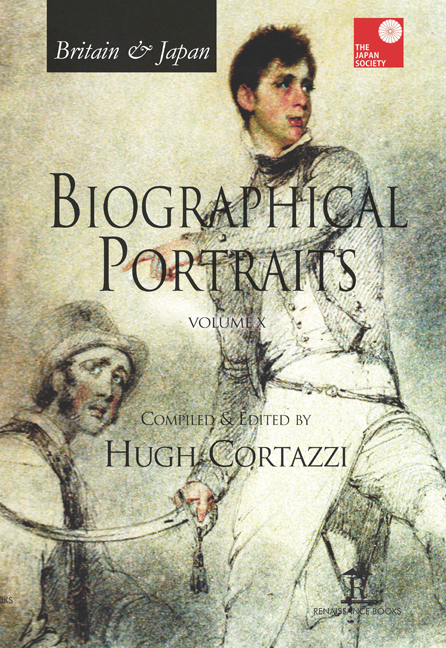Book contents
- Frontmatter
- Dedication
- Contents
- Introduction
- List of Contributors
- Index of Biographical Portraits in Japan Society Volumes
- PART I BRITAIN IN JAPAN
- PART II JAPAN IN BRITAIN
- Select Bibliography of Works in English on Anglo-Japanese Relations [Compiled by Gill Goddard – Retired East Asian Studies Librarian, University of Sheffield]
- Select Bibliography of Works in Japanese on Anglo-Japanese Relations [Compiled by Akira Hirano, SISJAC]
- Index
66 - Katō Shōzō (1863–1930) and Tomita Kumasaku (1872–1953): Japanese Art Dealers in London:
Published online by Cambridge University Press: 07 May 2022
- Frontmatter
- Dedication
- Contents
- Introduction
- List of Contributors
- Index of Biographical Portraits in Japan Society Volumes
- PART I BRITAIN IN JAPAN
- PART II JAPAN IN BRITAIN
- Select Bibliography of Works in English on Anglo-Japanese Relations [Compiled by Gill Goddard – Retired East Asian Studies Librarian, University of Sheffield]
- Select Bibliography of Works in Japanese on Anglo-Japanese Relations [Compiled by Akira Hirano, SISJAC]
- Index
Summary
INTRODUCTION
WHEN JAPANESE ART became fashionable in Britain in the latter part of the nineteenth century, at first mainly British dealers, such as Liberty & Co, sold Japanese art works and antiques in London. After the Fine Art Society's Loan Exhibition of Japanese Art in London in 1888, Japanese native art dealers and merchants gradually started to sell Japanese art works and antiques in London. Among Japanese art dealers before the Second World War, the most prominent and well-established was probably Yamanaka & Co. (Yamanaka Shōkai).
Minakata Kumagusu (1867–1941), a distinguished scholar of mucus fungi and also of manners and customs, lived in London for almost eight years from September 1892 to September 1900. Minakata kept a diary throughout his time in London. He became acquainted withmembers of the Japanese community in London, including those involved in the business of selling Japanese art works and antiques. Yamanaka & Co. arrived in London just before the end of Minakata's stay in London. The years from 1890s up to the First World War were probably the most active period for Japanese native art dealers in London. Minakata’s London Diary detailed his encounters with many of the London- based Japanese art dealers, such as Katō Shōzō (1863?-1930), Tomita Kumasaku (1872–1963), Eida Saburō (1858–1911), Hosoi Ogawa Tanosuke (H.O. Tanosuke), Kataoka Masayuki (Prince Kataoka) and Yamanaka & Co. His diary is one of the most important sources of information about these dealers and I have drawn extensively on them in these brief portraits of Katō Shōzō and Tomita Kumasaku.
KATŌ SHŌZŌ
According to Minakata Kumagusu, Katō Shōzō was a son of a principal retainer of the daimyo (Matsudaira,) of the Oshi Clan in what became Saitama Prefecture. He is also described as being talented in the traditional performing arts. Katō was also said to have come from Osaka. The address of his shop in Japan was Takeyacho, Minami-ku, Osaka-shi’, which was registered in the Japanese directories for overseas business activities.
When the Japanese residents of London celebrated the enthronement of the Showa Emperor on 10 November 1928, Katō Shōzō sang nagauta (long ballads) and hauta (short love song) as part of the ceremonies. Shortly before this celebration, he had contributed a short article to Nichi-Ei Shinshi (a monthly newspaper published in London in Japanese and English), about his life as one of the earliest Japanese residents in England.
- Type
- Chapter
- Information
- Britain & Japan Biographical Portraits Vol X , pp. 754 - 760Publisher: Amsterdam University PressPrint publication year: 2016



